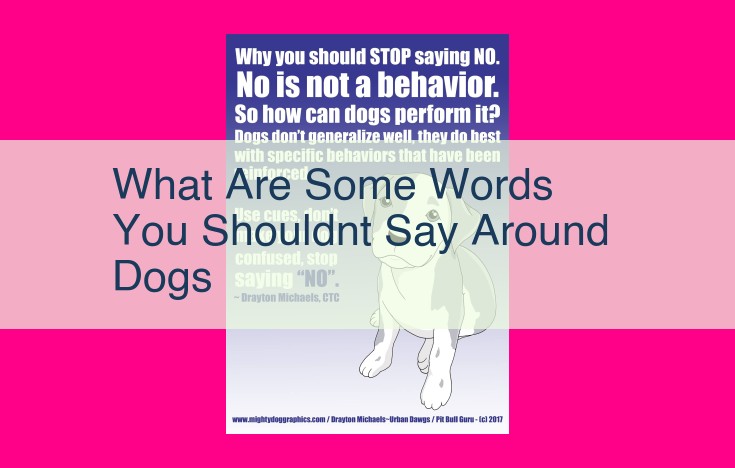Avoid Confusion, Anxiety, And Health Hazards: Communication Best Practices With Dogs

When interacting with dogs, avoid words that sound similar to their names, as this can lead to confusion. Additionally, steer clear of words associated with unpleasant experiences, as these can trigger anxiety. Furthermore, be cautious of using words related to foods that pose risks to dogs, as these can encourage unhealthy behaviors.
Choose Commands Different from Their Names: Why It Matters
When it comes to training your furry companion, choosing the right commands is crucial. Avoid commands that sound similar to your dog’s name. This can lead to confusion during training and make it difficult for your pet to distinguish between their name and command.
For instance, if your dog’s name is “Buddy,” avoid using commands like “sittie” or “biddy.” These commands bear a strong resemblance to the name and may confuse your dog. Instead, opt for clear and distinct commands like “sit” or “stay.”
Remember, the goal is to ensure your dog understands the difference between their name and commands. Hence, it’s vital to select commands that are easily distinguishable from the sound of their name.
Avoid Words Tied to Negative Experiences: Protect Your Dog’s Emotional Well-being
Dogs are incredibly sensitive beings, and their emotional states can be profoundly impacted by the words we use around them. Choosing words that trigger anxiety or fear can have a lasting, negative effect on their behavior and overall well-being.
Certain words can evoke unpleasant memories for dogs, particularly those associated with traumatic or painful experiences. For example, if a dog has been punished for growling in the past, the mere utterance of the word “growl” may send them into a state of anxiety. Similarly, words related to vet visits, grooming, or other unpleasant procedures can trigger fear or resistance.
It’s crucial to be mindful of the words we use and their potential impact on our dogs. Instead of using words tied to negative experiences, opt for more positive alternatives. For instance, instead of saying “no,” try using “leave it” or “drop it.” Instead of “bad dog,” try “oops” or “let’s try again.”
By using positive and encouraging language, we can foster a stronger bond with our dogs, build their confidence, and help them feel safe and secure in our presence. Remember, words have the power to shape our dogs’ emotional landscapes. Choose them wisely to ensure their happiness and well-being.
Keep Certain Food-Related Terms Off-Limits: Protecting Your Dog’s Well-being
In the realm of dog training, the words we utter hold immense significance. While selecting commands, it’s crucial to steer clear of terms that represent foods that can pose a threat to our furry companions. These “forbidden words” can trigger harmful behaviors, such as persistent begging or scavenging, which can compromise their health and safety.
Let’s delve into the reasons why it’s essential to avoid certain food-related words:
Dogs Associate Words with Experiences
Dogs possess remarkable memories and form strong associations between words and experiences. When exposed to terms that evoke positive feelings, such as “treat” or “biscuit,” their anticipation surges. However, words linked to negative or dangerous experiences, such as “chocolate” or “grapes,” can trigger anxiety or fear. Similarly, repeatedly uttering “bone” or “chicken” without providing the associated food item can lead to frustration and confusion.
Harmful Behaviors Linked to Food-Related Words
Exposure to words representing forbidden foods can inadvertently reinforce undesirable behaviors. For instance, a dog that hears the word “chocolate” may start begging or searching for it, increasing the likelihood of ingesting this toxic substance. By using these terms casually, we inadvertently cue our dogs to engage in potentially harmful activities.
Indigestible Foods and Health Risks
Some foods, although not toxic, can be highly indigestible for dogs. Terms like “onion” or “garlic” may not trigger immediate distress, but they can lead to health problems over time. Repeated exposure to these words can encourage dogs to seek out and consume these foods, putting their digestive systems at risk.
Choosing Safe and Positive Food-Related Terms
To ensure our dogs’ well-being and promote effective training, it’s paramount to select food-related terms wisely. Consider using words that represent foods that are safe and appropriate for your dog’s diet. Instead of “chocolate,” opt for “carrots” or “apples.” Replace “grapes” with “blueberries” or “bananas.” By choosing positive and harmless terms, we can create a training environment that is enjoyable and beneficial for both dog and handler.